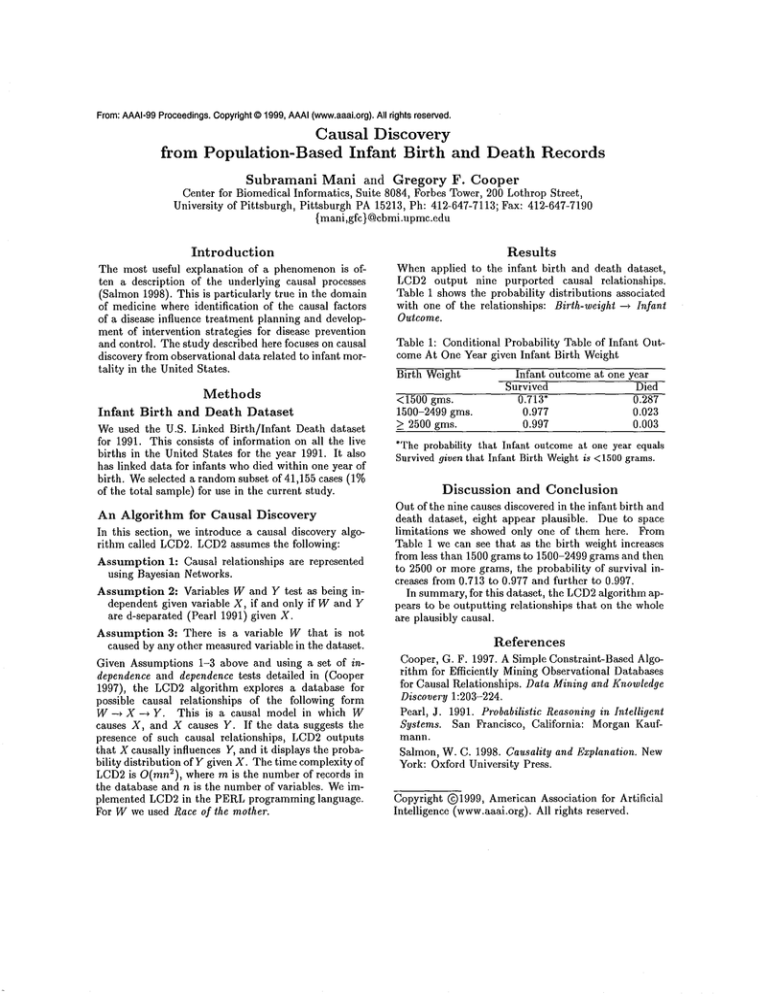Causal Discovery Subramani F.
advertisement

From:AAAI-99
Proceedings.
Copyright
©1999,AAAI(www.aaai.org).
All rights reserved.
from
Causal
Discovery
Population-Based
Infant
Birth
Subramani
Mani and Gregory
and Death
Records
F. Cooper
Center for Biomedical Informatics, Suite 8084, Forbes Tower, 200 Lothrop Street,
University of Pittsburgh, Pittsburgh PA 15213, Ph: 412-647-7113; Fax: 412-647-7190
{mani,gfc} @cbmi.upmc.edu
Introduction
The most useful explanation of a phenomenon is often a description of the underlying causal processes
(Salmon 1998). This is particularly true in the domain
of medicine where identification of the causal factors
of a disease influence treatment planning and development of intervention strategies for disease prevention
and control. The study described here focuses on causal
discovery from observational data related to infant mortality in the United States.
Methods
Infant
Birth and Death Dataset
We used the U.S. Linked Birth/Infant
Death dataset
for 1991. This consists of information on all the live
births in the United States for the year 1991. It also
has linked data for infants who died within one year of
birth. Weselected a random subset of 41,155 cases (1%
of the total sample) for use in the current study.
An Algorithm
for Causal
Discovery
In this section, we introduce a causal discovery algorithm called LCD2. LCD2assumes the following:
Assumption 1: Causal relationships
are represented
using Bayesian Networks.
Assumption 2: Variables Wand Y test as being independent given variable X, if and only if W and Y
are d-separated (Pearl 1991) given
Assumption 3: There is a variable W that is not
caused by any other measured variable in the dataset.
Given Assumptions 1-3 above and using a set of independence and dependence tests detailed in (Cooper
1997), the LCD2algorithm explores a database for
possible causal relationships of the following form
W--~X--~Y. This is a causal model in which W
causes X, and X causes Y. If the data suggests the
presence of such causal relationships,
LCD2outputs
that X causally influences Y, and it displays the probability distribution of Y given X. The time complexity of
LCD2is O(mn2), where m is the number of records in
the database and n is the number of variables. Weimplemented LCD2in the PERLprogramming language.
For Wwe used Race of the mother.
Results
Whenapplied to the infant birth and death dataset,
LCD2 output nine purported causal relationships.
Table 1 shows the probability distributions associated
with one of the relationships: Birth-weight ~ Infant
Outcome.
Table 1: Conditional Probability Table of Infant Outcome At One Year given Infant Birth Weight
Birth Weight
<1500 gms.
1500-2499 gins.
>_ 2500 gms.
Infant outcome at one year
Survived
Died
0.713"
0.287
0.977
0.023
0.997
0.003
*The probability that Infant outcome at one year equals
Survived given that Infant Birth Weightis <1500grams.
Discussion
and Conclusion
Out of the nine causes discovered in the infant birth and
death dataset, eight appear plausible. Due to space
limitations
we showed only one of them here. From
Table 1 we can see that as the birth weight increases
from less than 1500 grams to 1500-2499 grams and then
to 2500 or more grams, the probability of survival increases from 0.713 to 0.977 and further to 0.997.
In summary,for this dataset, the LCD2algorithm appears to be outputting relationships that on the whole
are plausibly causal.
References
Cooper, G. F. 1997. A Simple Constraint-Based Algorithm for Efficiently Mining Observational Databases
for Causal Relationships. Data Mining and Knowledge
Discovery 1:203-224.
Pearl, J. 1991. Probabilistic Reasoning in Intelligent
Systems. San Francisco, California:
Morgan Kaufmann.
Salmon, W. C. 1998. Causality and Explanation.
York: Oxford University Press.
New
Copyright Q1999, American Association for Artificial
Intelligence (www.aaai.org). All rights reserved.



